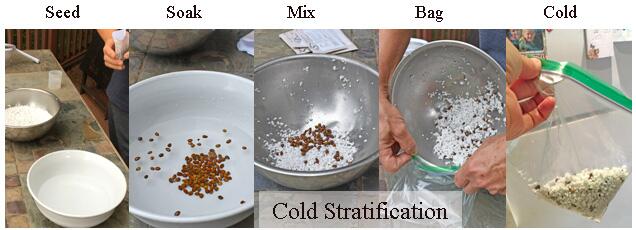Stratification means layering.
One method of breaking seed dormancy is to place a layer of a moist substrate.
( sand, peat moss, perlite etc.)
Then a layer of moist seed, another layer of a moist substrate, etc. The seed is then subject to the warm or cold temperature that it will need to break dormancy. This method is not widely used anymore but the name "stratification" is still used.
Today most Growers mix their moist seed and moist substrate together and place them in a plastic bag. These bags can easily be opened to inspect the seed regularly.
Cold Stratification: Many seeds mature on the plant in the Fall especially Tree Seeds. If they were to germinate at that time the Winter would kill them. Nature has given them built-in protection against this by requiring that they go through a period of cold temperature prior to germination. This requirement can be met in two ways. If you live in a northern climate and you are confident that the outdoor temperature will be below 40 degrees Fahrenheit for the 30, 60 or 90 days that we say the seed requires for cold stratification, then the seed can be sown in seedbeds outside in the fall, mulched heavily to prevent soil heaving and then remove most of the mulch in the Spring to allow the seed to germinate. The other way is to artificially condition the seed by soaking it in water and then drain the water and mix with an equal volume of moist perlite, peat moss etc. Place the seed in the refrigerator for the required time prior to sowing. The trickiest part of this is getting the moisture right. You need the stratification media to be moist but not wet. If you can ring water out of it then it is too wet. Mix the seed with this moist media and place it in a sealed plastic bag in the refrigerator. Check it every two weeks or so to make sure that it is the proper moisture and that the seeds are not molding or beginning to germinate. If there is any sign of mold they should be soaked in a solution of 10 parts water to 1 parts bleach, soak for 10 minutes, drain and wash thoroughly and put back into Stratification. If they are beginning to germinate they can be sown if the timing is right or kept as cold as possible (above freezing) until such time as you can sow them.
Warm Stratification: Some seeds require a period of after-ripening to soften the seed coat or allow the embryo to develop before undergoing cold stratification. This can be accomplished by following the cold stratification directions, except placing the moist seed at warm room temperature for the required period of time.
On our website each order page gives detailed growing instructions with the Stratification Techniques: for Example :
Chinese Kousa Dogwood. Cornus Kousa chinensis, one of the most beautiful small landscape trees.
For spring planting you may want to start the seed in January.
Scarification: Soak in water, let stand in water for 24 hours.
Stratification: cold stratify for 90 days.
Germination: sow seed 3/8" deep, tamp the soil, mulch the seed bed.
Other: fall sowing in mulched beds is preferred to artificial stratification.


Add new comment